Investment products
While we do not pre-determine the suitability of products for investors and their merit, we require that the offering documents of all retail investment products contain adequate and accurate disclosure for investors to make informed decisions.
Expanding range of renminbi investment products
With the Mainland government supporting Hong Kong’s development as an offshore renminbi centre, we made progress in making available to the Hong Kong public a wider and deeper pool of renminbi investment products during the year.
We worked closely with relevant Mainland authorities and quota holders of the RQFII scheme to facilitate the launch of the pilot programme immediately after the central government had announced it. The scheme allows Hong Kong subsidiaries of qualified Mainland fund managers and securities companies to use renminbi raised in Hong Kong to invest in Mainland securities markets. For the first time, by investing in funds set up under the scheme, Hong Kong’s retail investors can use renminbi to tap the Mainland equity and bond markets, in particular the interbank bond market. Since the scheme’s launch in December 2011, we authorized 19 RQFII funds with an aggregate RQFII quota size of RMB19 billion.
During the year, renminbi-denominated bond funds, which invest primarily in renminbi-denominated debt securities issued or distributed outside Mainland, continued to broaden the range of renminbi products. We authorized four such funds, bringing the total number of SFC-authorized renminbi-denominated bond funds to eight.
Other new renminbi product types we authorized include: the world’s first renminbi-denominated and traded gold exchange-traded fund (ETF) and the world’s first renminbi REIT.

Lipper Fund Awards 2012

Listing ceremony of Hang Seng RMB Gold ETF
Strengthening regulation of ETFs
According to market research, Hong Kong is the second largest ETF market in Asia (after Japan) in terms of market capitalisation. We authorized 25 ETFs during the year, bringing the total number of SFC-authorized ETFs to 89 at end-March 2012. Total market capitalisation reached US$97.4 billion at the end of the financial year, up 9.9% from the year-ago level of US$88.6 billion.
Market data shows that at 31 March 2012, 24 ETFs in Hong Kong tracked the performance of A-share indices. Their average daily turnover represented about 64% of the total ETF turnover.
To enhance investor protection, we introduced a requirement whereby SFC-regulated domestic synthetic ETFs must top-up the collateral level to achieve at least 100% collateralization by 31 October 2011 to ensure there is no uncollateralized counterparty risk exposure arising from the use of financial derivatives to replicate index performance. Where the collateral taken by these ETFs is in the form of equity securities, the market value of such equity collateral must be equivalent to at least 120% of the related gross counterparty risk exposure.
Transferring regulation of structured products
Following the relevant legislative change that took effect in May 2011, the regulation of the public offers of structured products in the form of shares or debentures was transferred from the prospectus regime of the Companies Ordinance to the regime for public offers of investments under the SFO. Under the new regime, the issue of advertisements and offering documents for all structured products (regardless of their legal forms) that are publicly offered must be authorized by the SFC, unless otherwise exempted by the SFO. During the year, we authorized 85 structured products and 141 offering documents of structured products.
Reviewing product KFS, offering documents
Commencing 25 June 2011, SFC-authorized funds and investment-linked assurance schemes were required to provide investors with a product key facts statement (KFS) and an offering document that satisfied a number of additional disclosure requirements.
In our surveillance exercise on a number of KFSs of SFC-authorized unit trusts and mutual funds and offering documents of SFC-authorized investment-linked assurance schemes, we noted that most of the documents reviewed were generally in compliance with our disclosure requirements. Among the small number of cases with disclosure issues, issuers subsequently made efforts to meet the required standards. As part of our ongoing effort to assist the industry in meeting regulatory requirements, we provided them with guidance on the production and refinement of disclosure in the documents.
Releasing survey on fund management activities
In July 2010, we released the Fund Management Activities Survey, which showed that Hong Kong’s combined fund management business reached $10,091 billion in 2010 (up 18.6% from 2009), outperforming the previous record level of $9,631 billion achieved in 2007. The increase suggests continuing inflows of investment capital into the Asia Pacific region.

